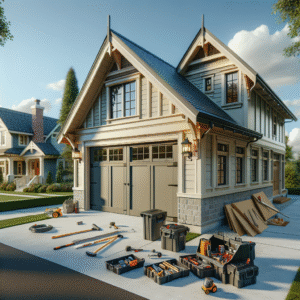If you’re looking to protect your home from water damage, especially in areas prone to flooding, installing a sump pump can be a game-changer. Sump pumps are crucial devices designed to remove water from basements and crawlspaces, preventing the accumulation that leads to flooding, mold, and structural damage. Whether you’re a seasoned DIYer or considering hiring a professional, understanding the basics of sump pumps, their types, and installation requirements is vital for ensuring your home remains dry and damage-free.
Understanding Sump Pump Basics: Types and Installation Requirements
Before diving into the installation process, it’s essential to understand what a sump pump is and the different types available. A sump pump is typically installed at the lowest point of your home’s basement or crawlspace in a specially constructed sump pit. Water flows into this pit either through drains or naturally by the soil, and the pump then redirects it away from your home to a place where it won’t cause any problems, like a storm drain or a dry well.
There are two primary types of sump pumps – the pedestal and submersible. The pedestal pump has its motor mounted above the sump, making it more accessible for maintenance and generally less expensive. On the other hand, the submersible pump is entirely mounted inside the sump, and sealed to prevent electrical short circuits, making it more suitable for homes with major water issues as it can handle larger volumes of water and operates more quietly.
Step-by-Step Guide to Installing a Sump Pump in Your Home
Installing a sump pump might seem daunting, but with the right tools and a bit of know-how, it’s a project that many homeowners can tackle over a weekend. This section of the article will provide you with a detailed, step-by-step guide covering everything from choosing the right pump to properly testing it after installation.
Essential Maintenance Tips for Prolonging the Life of Your Sump Pump
Like any other home appliance, a sump pump requires regular maintenance to function effectively. We’ll share some top tips to keep your sump pump in top working condition, helping you avoid costly repairs or replacements, and ensuring it’s ready when you most need it.
This comprehensive guide aims to arm you with all the information you need to manage your sump pump like a pro, whether you’re installing a new unit or maintaining an existing one. Let’s ensure your home stays dry and comfortable!

If you’re ready to take your home improvement or construction project to the next level, we can help! Find trusted contractors on BuildNet, whether you’re looking for renovations, new builds, electrical work, plumbing, or anything in between. Our directory connects you with qualified professionals who can make your vision a reality.
Understanding Sump Pump Basics: Types and Installation Requirements
Hey there! If you’re considering installing a sump pump or just curious about how they work, you’ve come to the right place. Let’s dive into the essentials of sump pumps, including the different types available and what you need to know before installation. This guide will arm you with the knowledge to make informed decisions, whether you’re planning to hire a professional or tackle the job yourself.
What Is a Sump Pump?
A sump pump is a nifty device used to prevent floods that can damage your home’s foundation and basement. It’s typically installed in the lowest part of your basement or crawlspace. Its primary job is to help keep the area under the building dry and to prevent it from flooding. Water flows into the sump pit through drains or by natural water migration through the soil. The pump’s job is to pump the water out of the pit and away from the building so the basement or crawlspace stays dry.
Types of Sump Pumps
When it comes to sump pumps, there are a couple of different types to consider:
Submersible Sump Pumps
- Design: These pumps are designed to be submerged in water. They are installed inside the sump pit and can handle large volumes of water efficiently, making them suitable for areas prone to serious flooding.
- Advantages: Quieter operation, longer lifespan, and they can handle debris in the water without much trouble.
Pedestal Sump Pumps
- Design: Unlike submersible pumps, pedestal pumps are mounted above the sump pit, with only the pump base and impeller placed into the pit. The motor is not meant to get wet.
- Advantages: Easier to maintain and repair since the motor is accessible, and usually less expensive than submersible pumps.
Installation Requirements
Installing a sump pump might seem daunting, but understanding the requirements can simplify the process. Here’s what you need to set up a sump pump in your home:
Choosing the Right Location
The best spot for a sump pump is at the lowest point of your basement or crawlspace where water naturally collects. Look for areas where the walls meet the floor, typically a corner, as this is often a low point.
Sump Pit Installation
A sump pit is essential for housing the sump pump. It’s usually made of plastic or fiberglass and should be around 18 inches wide and 22 to 30 inches deep. Make sure it is large enough to accommodate the pump and that it’s installed properly to avoid shifting or collapsing.
Check Local Building Codes
Before you start, it’s crucial to check your local building codes. Some areas have specific requirements for sump pump installation, such as the type of pump allowed, where it can discharge the water, and whether a backflow preventer is necessary.
Proper Discharge Location
It’s important to ensure that the water pumped out of your sump pit is directed away from your home to a place where it won’t cause problems. This could be a municipal storm drain or a dry well. Avoid directing water onto neighboring properties or back towards your home.
Electrical Requirements
Sump pumps require electricity to operate, so you’ll need a nearby outlet. It’s best to have a dedicated circuit for your sump pump to prevent overloading. Installing a battery backup system is also a wise choice to keep your sump pump running during power outages.
When to Call a Professional
While many enthusiastic DIYers might feel equipped to install a sump pump, it can involve complex considerations, like electrical installations and compliance with local building codes. If you’re not completely comfortable with any part of the installation process, calling a professional is a smart move. Local experts can ensure your sump pump is installed safely and correctly, tailored to your home’s specific needs.
Understanding the basics of sump pumps and their installation can save you a lot of stress and potential water damage. Whether you choose to install it yourself or hire a professional, knowing what’s involved will help you make the best decisions for your home. Remember, a well-installed and maintained sump pump is a long-term investment in the safety and comfort of your living space. Stay dry!

Step-by-Step Guide to Installing a Sump Pump in Your Home
Hello there, handy homeowners! Thinking about installing a sump pump in your basement? Well, you’ve come to the right place! Whether you’re dealing with occasional dampness or a basement that could double as a swimming pool, a sump pump can be your best defense against water damage. Let’s dive into a step-by-step guide on how to install a sump pump in your home—keeping things light, easy, and definitely doable!
Gather Your Tools and Materials
Before we roll up our sleeves, make sure you have all the necessary tools and materials. Here’s what you’ll need:
- Submersible sump pump: Opt for a reliable, high-quality model.
- Gravel: Required for proper drainage around the pump.
- PVC piping: To direct the water out of your home.
- Check valve: Prevents the backflow of drained water.
- Sump basin: Houses the sump pump.
- Power drill: For drilling holes in the basin.
- Plywood: For covering the basin.
- Concrete mix: For securing the basin.
- Standard plumbing tools: Wrenches, screwdrivers, etc.
Choose the Right Location
Finding the perfect spot for your sump pump is crucial. Ideally, you want to place it in the lowest part of your basement where water tends to accumulate. Also, ensure it’s near a GFCI (Ground Fault Circuit Interrupter) outlet to avoid electrical hazards. Remember, proper placement not only maximizes efficiency but also minimizes noise.
Prepare the Sump Pit
Now, let’s get our hands dirty:
- Dig the pit: Using a jackhammer or shovel, dig a hole about 6 to 8 inches deeper than the sump basin and wide enough to accommodate it.
- Add gravel: Fill the bottom of the hole with a few inches of gravel. This aids in drainage and helps to support the pump.
- Place the basin: Settle the basin into the hole and ensure it’s level. Stability is key!
- Secure the basin: Mix enough concrete to surround the basin. Pour the concrete around the perimeter to fix the basin firmly in place. Let it set for 24 hours.
Install the Sump Pump
With your pit ready, installing the pump is next:
- Place the pump: Carefully place the sump pump into the basin.
- Pipe installation: Attach PVC pipes to the pump’s outlet, routing them towards the exterior of your home. Ensure a continuous slope in the piping to aid water flow.
- Check valve: Install a check valve on the PVC pipe. This prevents the water that exits the pump from flowing back into the basin.
- Test the pump: Pour water into the basin until the pump activates. Watch the water flow and check for any leaks or malfunctions.
Seal and Cover
Almost there! Let’s wrap this up:
- Seal the edges: Apply silicone sealant around the basin edges where it meets the floor. This prevents water seepage around the basin.
- Cover the pit: Cut a piece of plywood to cover the sump basin. This will prevent debris from falling in and minimize noise.
Voilà! You’ve just installed a sump pump in your home. It wasn’t that hard, right? This DIY project not only safeguards your basement against moisture and flooding but also adds value to your home. Remember, the key is to take it step by step, and before you know it, you’ll be a sump pump-installin’ pro!
What’s Next?
Now that you’ve got your sump pump in place, keep it running smoothly by following regular maintenance tips (but that’s a story for another day). Feel free to pat yourself on the back and maybe even brag a little to your neighbors. After all, you’ve just enhanced your home’s integrity and your peace of mind! Until next time, keep on fixing, and stay dry!
Essential Maintenance Tips for Prolonging the Life of Your Sump Pump
Hey there! If you’re the proud owner of a sump pump, you already know how crucial it is for keeping your basement dry and safe from water damage. But, like any other appliance in your home, it needs a little TLC to keep it running smoothly. Let’s dive into some essential maintenance tips that will help prolong the life of your sump pump, ensuring your home stays dry and your pump stays happy.
Regular Cleaning: The Key to Reliable Operation
First things first, keeping your sump pump clean is non-negotiable. Over time, debris, dirt, and other sediments can accumulate in your sump basin. This not only affects the efficiency of your pump but can also lead to malfunctions or complete failure.
- Check and Clean the Screen/Inlet: This should be done at least once a year. Remove any debris that might block water flow.
- Vacuum the Sump Pit: Use a wet-vac to remove any standing debris in the pit. A clear pit allows for better water flow and reduces the risk of clogs.
Test Your Pump Regularly
Testing your sump pump ensures it’s ready for action when you need it most. It’s like a fire drill for your pump!
- Perform a Water Test: Pour enough water into the pit to trigger the pump. Watch to ensure it starts automatically and the water drains quickly once the pump is on.
- Listen to Your Pump: Does it make any strange noises when it runs? Grinding or rattling could indicate a problem.
Check the Power Source
Your sump pump’s power source is like its lifeline. Ensuring it’s in top shape is crucial:
- Secure Connections: Verify that the pump is plugged into a working ground fault circuit interrupter (GFCI) outlet and that it’s not loosely connected.
- Battery Backup: If your pump has a battery backup, routinely check the battery’s charge and replace it every 2-3 years.
Inspect and Replace Worn Parts
Wear and tear on your sump pump are inevitable. Keeping an eye on its components can save you a lot of hassle:
- Check the Float Switch: This is a common failure point. Test its mobility and replace it if it’s not triggering the pump at the correct water level.
- Look for Signs of Corrosion: Any visible rust or corrosion can be a sign that parts may need replacing to prevent future failures.
Professional Inspections
Sometimes, it’s best to call in the pros. Having a professional plumber or a sump pump expert inspect your system can help catch issues you might miss:
- Annual Check-ups: Schedule these like you would a medical physical – they’re essential for health, both for you and your pump.
- Post-Season Reviews: After a heavy storm season or a period of frequent pump activation, getting a professional once-over can help extend your pump’s lifespan.
Mind the Weather
Extreme weather conditions can put additional stress on your sump pump. Here’s how you can mitigate risks:
- Winter Care: Disconnect and remove your pump if temperatures drop below freezing to prevent damage.
- Summer Storms: Ensure your pump is in working order before the season hits. This is when you’ll need it the most!
Keep an Eye on the Discharge Line
The discharge line is your pump’s way of sending water away from your foundation. Keeping this line clear is crucial:
- Ensure Proper Routing: The line should direct water away from your home without any loops or uphill segments where water could remain and freeze.
- Check for Clogs: Regularly inspect the outlet of the discharge line and clear any obstructions like leaves, dirt, or ice.
Remember, maintaining your sump pump isn’t just about prolonging its life; it’s about keeping your home safe from the nightmares of water damage. With these tips, your pump will be more reliable, efficient, and ready to tackle whatever Mother Nature throws its way. Stay dry and carry on!

What Types of Sump Pumps Are Available?
There are two main types of sump pumps: submersible and pedestal. A submersible pump is installed completely underwater in your sump pit, making it quieter and generally more effective. A pedestal pump, on the other hand, has a motor mounted above the sump, making it easier to service but a bit noisier. Choosing the right type depends on your basement’s size, the amount of water you need to manage, and noise preferences.
What Should I Consider Before Installing a Sump Pump?
Before installation, consider the size of your sump pit, the water table level in your area, and the typical volume of water you need to manage. Additionally, check local building codes to determine if a permit is needed and ensure your installation complies with all regulations. Don’t forget to think about the power supply too; a backup power source is recommended in case of power outages.
What Are the Steps to Install a Sump Pump?
Installing a sump pump involves several key steps:
- Prepare the Sump Pit: Clear debris and ensure the pit is deep and wide enough for your pump.
- Install the Pump: Place the pump in the pit, ensuring it’s level and stable.
- Connect the Discharge Pipe: Attach and seal the discharge pipe to the pump.
- Test the Pump: Pour water into the pit to test the pump’s activation and operation.
- Seal the Pit: Cover the pit with a sturdy lid to prevent debris and moisture from entering.
Remember that incorrect installation can lead to pump failure, so if you’re not confident, it’s best to contact a professional.
How Often Should I Maintain My Sump Pump?
Regular maintenance, ideally every 3-4 months, is crucial for ensuring your sump pump’s longevity. Check the operation by pouring water into the pit, clean the grate, and inspect the valve and discharge line for blockages or leaks. Additionally, consider a professional inspection annually.
What Are the Common Signs of Sump Pump Failure?
Be on the lookout for these warning signs:
- Strange Noises: Grinding or rattling noises may indicate a jammed or damaged pump.
- Continuous Operation: If the pump doesn’t turn off, it might be due to a switch problem or high water table.
- Visible Rust: Corrosion can hinder the pump’s effectiveness and lead to failure.
- Slow Operation: Slow or ineffective pumping could be due to a clogged intake or failing motor.
These signs suggest it’s time for maintenance or possibly a replacement.
Can Power Outages Affect My Sump Pump?
Yes, since most sump pumps rely on your home’s electricity to operate, power outages can stop the pump from working when it’s most needed. Consider installing a battery backup system or opting for a water-powered backup pump if you live in an area with frequent power outages.
Is It Possible to Install a Sump Pump Without a Professional?
While DIY installation is possible, sump pump installation can be complex and errors can be costly. If you’re not experienced in plumbing or electrical work, hiring a professional is advisable. They can ensure that the installation is performed safely and compliantly, offering peace of mind and potentially saving you from costly mistakes.
When Should I Replace My Sump Pump?
Typically, a sump pump should be replaced every 7-10 years, depending on usage and maintenance. Signs like frequent malfunctions, continuous operation, or inefficiency in water removal are clear indicators that it’s time for a new sump pump.
Conclusion
Installing and maintaining a sump pump can significantly reduce the risk of basement flooding, protecting your home from water damage. By understanding the different types of pumps available and their specific installation requirements, you’re well on your way to safeguarding your property. Remember, regular maintenance is key to prolonging the life of your sump pump and ensuring it operates efficiently when you need it most.
If you’re ready to install or service a sump pump but need professional assistance, don’t hesitate to visit the BuildNet website. We can connect you with experienced local contractors who can provide a free quote and expert advice. Protecting your home is a top priority, and with the right help, you can ensure your sump pump system is up to the task.







